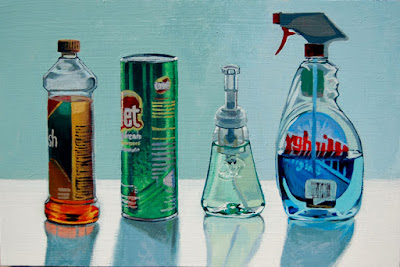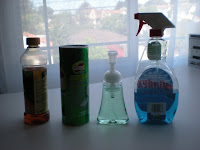


The way to form transcends its own destination, goes beyond the end of the way itself. Paul Klee
I set out to paint a still life this week. Since I have northern light from a large window, I placed a large piece of foam board on top of a table right by it. I had a birch panel that I had primed with gesso, the cheapest acrylics available on the market, and some cheap nylon and hog brushes. I experimented for a while with various household objects as subjects, because their properties attracted me. Wanting to demonstrate certain principles in figurative work to my future students at the Richmond Art Center is what propelled me to go beyond my comfort zone.
I settled for a lineup composition and began painting. But I didn't bother to check some important things, such as whether my lines were straight, because I was too excited by the beginning. I was not thrilled at having to watch things like symmetry and whether or not a reflection makes sense or not, but this is what we get into when painting man-made objects. I "forgot" I have astigmatism, which means that when I am not wearing glasses I distort lines. And I don't wear my glasses because I like not seeing all the details so I can concentrate on other things.
So towards the end of the ten hours it took me, instead of looking at the overall values, I had to spend time correcting the vertical lines in two of these objects with a straightedge. Ugh. Then I noticed there was a lot of room for play in this painting and my mood lightened up. The reflections were subtle and so was the lighting. There was some color, but nothing too dramatic. So I could contribute much to the painting merely by making subtle choices in execution, values and color. And best of all, I could spend as much or as little time as I needed, which is the biggest advantage of working indoors.
I have "desaturated" a picture of the finished painting in Photoshop (the black and white photo). This lets you see pure value and you can check if the values work. One of the purposes of studying painting as a discipline is to train your mind to do this on its own, without Photoshop. You want to develop the ability to ignore color at will, and ignore value to concentrate on color if you need to evaluate either. I started out with a palette composed of eight colors, but ended up using mostly titanium white, pthalo green, alizarin crimson, cadmium yellow and cerulean blue.
If you compare the photo of the setup with the finished painting, you will notice all of the values and color an artist's eye can see, versus what the camera captures. This is why it is much better to revise from memory, because the colors I remembered were much more vivid than those in the painting. Even though painters are limited by the pigments with which we imitate the effects of light, it is still possible approximate those effects with good pigment choices and good value work.
Finally, I feel I should say this was not a mere exercise. I love the juxtaposition of forms in this still life, and the subtle color. But mot important for me is to train my perception to think of all of these factors.




